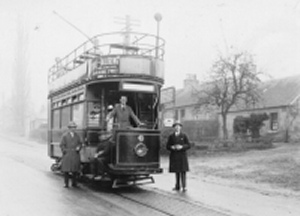

|
|||||||||
|
|
|
|
|
|
|
|
|
|
|
|
September 17th 1895 |


|
The tramcars of Perth
Tram conductor, actor and playwright Donald Paton (right) beside the very last Scone - Perth tram. Picture from Donald Paton (Jnr) It was on September 17th 1895 that the Perth and District Tramways Company officially opened the line from the rapidly expanding village of Scone to Glasgow Road, Perth. The trams were drawn by pairs of horses, the service ran at half hour intervals and the fare was 3d for the complete journey from Rose Terrace to Scone. The service was sufficiently successful for the frequency to be soon increased to once every twenty minutes and within a year new tracks were constructed to Priory Place in Craigie via King Street, and St Leonard’s Bank to Cherrybank from Rose Terrace, and to Dunkeld Road via Barrack Street. Though the horse drawn trams obviously gave a satisfactory service, there was soon talk of electrifying the network. The Town Council had already bought out the original company and steps were taken in 1904 to purchase twelve new electric tram cars, to build a power station at the Shore and to proceed with new track and overhead cables. On October 31st 1905, the first of the new trams ran from the High Street to the depot at Scone carrying the Town Council and their guests. In the evening, one of the trams ran with the corporation band giving selections from the upper deck. In spite of the high hopes entertained by the Council, the new service never ran at a profit. Various measures were taken to increase profitability but none had the desired effect. During the 1914-18 war, maintenance of the track was to a large extent neglected, and by 1919 the Council was faced with the decision of whether to spend a considerable amount of money on new equipment or to phase out the trams in favour of buses. To some extent the Corporation’s hands were tied by an order passed in Parliament in 1908 which gave the Corporation “power to run omnibuses within the Burgh and also in connection with the tramways beyond the Burgh for a distance not exceeding three miles from any part of the tramway.” The Council decided to purchase a number of buses, and by 1927 had made the decision to phase out the tram service and to provide merely a skeleton tram service to enable them to keep within the 1908 Act. In the meantime, a new order was promoted to allow the Corporation to run buses in all localities. The tram service continued to run down and by the end of 1928 only two cars were still serviceable. They made one or two daily trips over the system but rarely carried any passengers. Finally on January 19th with no fanfares and not very much interest, the last car performed its last journey in Perth. The era of the tram was over. |

